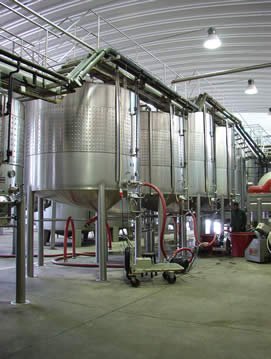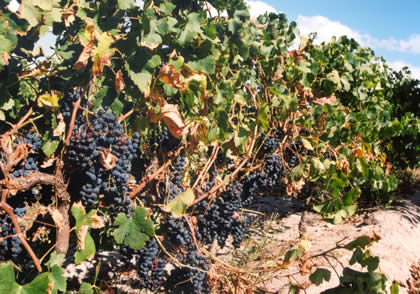|
Naturalness
in wine: how much manipulation is acceptable?
 Wine can be made naturally. It
almost makes itself. At its most simple, the process of making wine
involves harvesting grapes, sticking them into a vat, crushing them a
bit and letting them ferment. When fermentation is complete, separate
out the solid matter from the liquid, and you have wine. Wine can be made naturally. It
almost makes itself. At its most simple, the process of making wine
involves harvesting grapes, sticking them into a vat, crushing them a
bit and letting them ferment. When fermentation is complete, separate
out the solid matter from the liquid, and you have wine.
But winemakers almost always add
things to their wine. There are several reasons for this, some of them
better than others, and this leads to a thorny question that’s at
the heart of many of the most passionate debates in winemaking
circles: just how much manipulation is acceptable?
There’s no simple answer.
It’s a grey area and any attempt to proscribe permissible levels of
manipulation is a line-drawing exercise. But just because it is
difficult to make these sorts of distinctions, it doesn’t mean that
we shouldn’t try to make them. Wine laws exist in virtually all wine
producing regions or countries that outline which sorts of
manipulations are acceptable and which aren’t. Some are stricter
than others. To get an understanding of the issues involved, let’s
consider four different positions and assess their strengths and
weaknesses.
1. Anything goes
Should a wine be judged purely on how it
tastes? Is drinking wine just a sensory experience? Some people argue
that this is the case. If it is, then there are no real reasons to
prohibit additives. The answer is in the glass, and if there are ways
of making wine taste ‘better’, then they should be allowed. The
weakness of this position is that it ignores the fact that wine is a
discretionary purchase. Certainly, fine wine is something that people
buy partly because it isn’t manufactured: the grapes aren’t just
seen as the raw materials that act as a starting point in the manufacturing
process. Grapes have a connection to the soil, to the
vineyard they are from. Part of the appeal of wine is that it is a
‘natural’ product rich in culture, and its image will suffer if
absolutely anything is allowed.
2. Add nothing
This is an extreme position for one reason
– SO2. Sulphur dioxide (SO2) is intrinsic to
winemaking because it’s hard to make good quality wine without it:
it plays a vital role as an antioxidant and also as a microbicide
preventing the growth of harmful bacteria and rogue yeasts. It is
added during winemaking and at bottling. Some winemakers bravely
attempt to make SO2-free wines for the sake of naturalness
or for health reasons, but it needs to be borne in mind that SO2
is produced naturally during fermentation in non-negligible amounts
anyway.
3. Add as little as possible
This is a laudable position, for the reason
mentioned earlier that wine is perceived by consumers as a natural
product, and this is part of its appeal. A sensible winemaking policy
is only to add something if not adding it is going to compromise wine
quality, and then only add as little as possible. It’s tough to make
good wine with no SO2, but the effect of any additions can
be maximized by smart use and good winemaking practice. Acid additions
might be needed in warm climates, because high pH compromises wine
quality and reduces the effectiveness of any SO2 that is
added.
 This raises the question of
other sorts of wine manipulation. For centuries oak barrels have been
used to make wine, and the use of them is uncontroversial partly
because they are traditional. The use of new oak barrels certainly
would count as an additive manipulation because they contribute
important flavour components to the wine. Intelligent barrel use is a
vital component of the winemaking process for the majority of fine
wines, and it’s hard to imagine doing without them altogether. But
consider what might happen if they’d never been used for wine and
someone tried introducing them now: there’d likely be a bit of an
outcry. So, is it hypocritical to allow barrel use but exclude newer
high-tech manipulations such as microoxygenation and reverse osmosis?
These tools are seen as pretty interventionist, but it is possible to
use them with pure motives. This raises the question of
other sorts of wine manipulation. For centuries oak barrels have been
used to make wine, and the use of them is uncontroversial partly
because they are traditional. The use of new oak barrels certainly
would count as an additive manipulation because they contribute
important flavour components to the wine. Intelligent barrel use is a
vital component of the winemaking process for the majority of fine
wines, and it’s hard to imagine doing without them altogether. But
consider what might happen if they’d never been used for wine and
someone tried introducing them now: there’d likely be a bit of an
outcry. So, is it hypocritical to allow barrel use but exclude newer
high-tech manipulations such as microoxygenation and reverse osmosis?
These tools are seen as pretty interventionist, but it is possible to
use them with pure motives.
On balance, the case of
accepting older, traditional manipulations and avoiding newer ones
does have a sound basis: that of preserving product integrity in the
eye of the consumer. The ‘adding as little as possible’ school
would no doubt object to newer hi-tech manipulations, although at a
stretch it could be argued that alcohol reduction by RO would prevent
excessive alcohol levels from compromising wine quality and thus
should be allowed.
4. The in-between position
The final position would be permit some
manipulations but not those that could be deemed as ‘cheating’.
Openness and honesty is the key here: adding most things is OK as long
as their use is disclosed and wine laws don’t outlaw them. Where
should the line be drawn? A strong argument could be made for banning
manipulations such as non-traditional chemical flavourants but
allowing the winemaker access to other techniques if they choose to
use them. I can’t imagine anyone seriously arguing that fruit
flavourings or non-wine fruits can be used and the substance still be
labelled as wine. On the other hand, this more relaxed view would
permit reverse osmosis and microoxygenation. They are, like other
technologies, merely tools, and tools can be used well or they can be
used badly. What counts is how well the tools are used, not whether
they are used or not.
Summary
Ultimately, a relationship of trust exists between winemakers and
consumers. I feel that where manipulations are used, they should be
declared, and then consumers can make their purchasing choice with
this in mind. If they want a wine that’s totally ‘natural’, with
no SO2 added, then that’s fine. If they want a wine from
a producer who uses as little manipulation as possible, this is also
fine. If they don’t mind how the wine was made and only care about
the taste, that’s their choice also. Currently, producers seem a
little shy to disclose exactly how their wines are made. Is that
because they suspect many consumers would be surprised by the degree
of manipulation that does take place with some wines? Perhaps they are
afraid to shatter the popular conception is that wine is a relatively
‘natural’, additive-free product.
The various means for
manipulating wines are just tools: as such they can be used wisely,
used badly, or not employed at all. Whether or not the use of these
tools is justified is a decision that can’t easily be made globally
and enshrined in legislation. Would you rather have a flawed natural
wine, when a simple manipulation would have eliminated the fault?
It’s a difficult, multilayered question (for example, what is
‘flawed’ in the context of a wine?). That’s why I would advocate
a policy of freedom of operation for the winemaker, coupled with
honesty about disclosing to the consumer if any ‘manipulations’
are used.
There exists a case for
suggesting that different categories of wines should be treated
differently. While manipulations might be necessary to help out a
commodity wine made from less than perfect grapes, there’s less of a
case for using more manipulation than is absolutely necessary for fine
wines. Rules are important to preserve wine integrity and protect
consumers from fakes, but they should be implemented locally rather
than globally. Some manipulations, such as adding chemicals as
flavouring agents (whether they occur naturally in the wine or not)
are defenceless and should be banned altogether.
The danger with too much
technology is that it gives winemakers too many tools to tweak their
wines. Coupled with the increased influence of critics favouring
certain types of wines, the temptation for winemakers is to use these
tools to iron out any ‘edges’ in their wines. The consequence? All
wines begin to taste alike, and variations in vintage and terroir
expression – sources of interest – are diminished. A nightmare
scenario for lovers of traditional wines.
Back to top
|

 Wine can be made naturally. It
almost makes itself. At its most simple, the process of making wine
involves harvesting grapes, sticking them into a vat, crushing them a
bit and letting them ferment. When fermentation is complete, separate
out the solid matter from the liquid, and you have wine.
Wine can be made naturally. It
almost makes itself. At its most simple, the process of making wine
involves harvesting grapes, sticking them into a vat, crushing them a
bit and letting them ferment. When fermentation is complete, separate
out the solid matter from the liquid, and you have wine. 